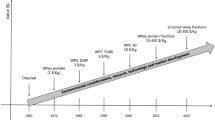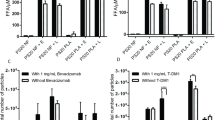Abstract
This study examined the effect of buffer salts on the physical stability of spray-dried and lyophilized formulations of a model protein, bovine serum albumin (BSA). BSA formulations with various buffers were dried by either lyophilization or spray drying. The protein powders were then characterized using solid-state Fourier transform infrared spectroscopy (ssFTIR), powder X-ray diffraction (PXRD), size exclusion chromatography (SEC), solid-state hydrogen/deuterium exchange with mass spectrometry (ssHDX-MS), and solid-state nuclear magnetic resonance spectroscopy (ssNMR). Particle characterizations such as Brunauer-Emmett-Teller (BET) surface area, particle size distribution, and particle morphology were also performed. Results from conventional techniques such as ssFTIR did not exhibit correlations with the physical stability of studied formulations. Deconvoluted peak areas of deuterated samples from the ssHDX-MS study showed a satisfactory correlation with the loss of the monomeric peak area measured by SEC (R2 of 0.8722 for spray-dried formulations and 0.8428 for lyophilized formulations) in the 90-day accelerated stability study conducted at 40°C. mDSC and PXRD was unable to measure phase separation in the samples right after drying. In contrast, ssNMR successfully detected the occurrence of phase separation between the succinic buffer component and protein in the lyophilized formulation, which results in a distribution of microenvironmental acidity and the subsequent loss of long-term stability. Moreover, our results suggested that buffer salts have less impact on physical stability for the spray-dried formulations than the lyophilized solids.










Similar content being viewed by others
Change history
29 December 2023
A Correction to this paper has been published: https://doi.org/10.1007/s11095-023-03639-1
References
Cicerone MT, Pikal MJ, Qian KK. Stabilization of proteins in solid form. Adv Drug Deliv Rev. 2015;93:14–24.
Carpenter JF, Chang BS, Garzon-Rodriguez W, Randolph TW. Rational design of stable lyophilized protein formulations: theory and practice. Pharm Biotechnol. 2002;13:109–33.
Langford A, Bhatnagar B, Walters R, Tchessalov S, Ohtake S. Drying technologies for biopharmaceutical applications: Recent developments and future direction. Drying Technol. 2018;36(6):677–84.
Chen Y, Tejasvi Mutukuri T, Wilson NE, Zhou Q. Pharmaceutical protein solids: drying technology, solid-state characterization and stability. Adv Drug Deliv Rev. 2021;172:211–33.
Ameri M, Maa Y-F. Spray drying of biopharmaceuticals: stability and process considerations. Drying Technol. 2006;24(6):763–8.
Cun D, Zhang C, Bera H, Yang M. Particle engineering principles and technologies for pharmaceutical biologics. Adv Drug Deliv Rev. 2021;174:140–67.
Lee G. Spray-drying of proteins. Pharm Biotechnol. 2002;13:135–58.
White S, Bennett DB, Cheu S, Conley PW, Guzek DB, Gray S, Howard J, Malcolmson R, Parker JM, Roberts P. EXUBERA®: pharmaceutical development of a novel product for pulmonary delivery of insulin. Diabetes Technol Ther. 2005;7(6):896–906.
Ferrati S, Wu T, Fuentes O, Brunaugh AD, Kanapuram SR, Smyth HDC. Influence of Formulation Factors on the Aerosol Performance and Stability of Lysozyme Powders: a Systematic Approach. AAPS PharmSciTech. 2018;19(7):2755–66.
Wilson NE, Topp EM, Zhou QT. Effects of drying method and excipient on structure and stability of protein solids using solid-state hydrogen/deuterium exchange mass spectrometry (ssHDX-MS). Int J Pharm. 2019;567: 118470.
Wilson NE, Mutukuri TT, Zemlyanov DY, Taylor LS, Topp EM, Zhou QT. Surface Composition and Formulation Heterogeneity of Protein Solids Produced by Spray Drying. Pharm Res-Dordr. 2020;37(1):14.
Wilson NE, Mutukuri, T.T., Zemlyanov, D.Y., Topp, E.M., Zhou, Q.T. Effects of Surfactant Inclusion in Heterogeneity of Spray-dried Protein Formulations Determined by X-ray Photoelectron Spectroscopy and Solid-state Hydrogen/Deuterium Exchange with Mass Spectrometry. In.; 2020.
Wang W. Instability, stabilization, and formulation of liquid protein pharmaceuticals. Int J Pharm. 1999;185(2):129–88.
Cleland JL, Powell MF, Shire SJ. The Development of Stable Protein Formulations - a Close Look at Protein Aggregation, Deamidation, and Oxidation. Crit Rev Ther Drug. 1993;10(4):307–77.
Manning MC, Chou DK, Murphy BM, Payne RW, Katayama DS. Stability of protein pharmaceuticals: an update. Pharm Res. 2010;27(4):544–75.
Trissel LA. Handbook on injectable drugs. In. Handbook on Injectable Drugs; 2007. p. 1720–1720.
Park J, Nagapudi K, Vergara C, Ramachander R, Laurence JS, Krishnan S. Effect of pH and excipients on structure, dynamics, and long-term stability of a model IgG1 monoclonal antibody upon freeze-drying. Pharm Res. 2013;30(4):968–84.
Ugwu SO, Apte SP. The effect of buffers on protein conformational stability. Pharm Technol. 2004;28(3):86–109.
Zbacnik TJ, Holcomb RE, Katayama DS, Murphy BM, Payne RW, Coccaro RC, Evans GJ, Matsuura JE, Henry CS, Manning MC. Role of Buffers in Protein Formulations. J Pharm Sci. 2017;106(3):713–33.
Ohtake S, Schebor C, Palecek SP, de Pablo JJ. Effect of pH, counter ion, and phosphate concentration on the glass transition temperature of freeze-dried sugar-phosphate mixtures. Pharm Res. 2004;21(9):1615–21.
Gomez G, Pikal MJ, Rodriguez-Hornedo N. Effect of initial buffer composition on pH changes during far-from-equilibrium freezing of sodium phosphate buffer solutions. Pharm Res. 2001;18(1):90–7.
Sundaramurthi P, Suryanarayanan R. Predicting the Crystallization Propensity of Carboxylic Acid Buffers in Frozen Systems-Relevance to Freeze-Drying. J Pharm Sci-Us. 2011;100(4):1288–93.
Sundaramurthi P, Shalaev E, Suryanarayanan R. Calorimetric and diffractometric evidence for the sequential crystallization of buffer components and the consequential pH swing in frozen solutions. J Phys Chem B. 2010;114(14):4915–23.
Sundaramurthi P, Shalaev E, Suryanarayanan R. “pH Swing” in Frozen Solutions-Consequence of Sequential Crystallization of Buffer Components. J Phys Chem Lett. 2010;1(1):265–8.
Chen Y, Ling J, Li M, Su Y, Arte KS, Mutukuri TT, Taylor LS, Munson EJ, Topp EM, Zhou QT. Understanding the Impact of Protein-Excipient Interactions on Physical Stability of Spray-Dried Protein Solids. Mol Pharm. 2021;18(7):2657–68.
Sun WQ, Davidson P. Protein inactivation in amorphous sucrose and trehalose matrices: effects of phase separation and crystallization. Biochimica et Biophysica Acta (BBA) - General Subjects. 1998;1425(1):235–244.
Heller MC, Carpenter JF, Randolph TW. Protein formulation and lyophilization cycle design: Prevention of damage due to freeze-concentration induced phase separation. Biotechnol Bioeng. 1999;63(2):166–74.
Mensink MA, Nethercott MJ, Hinrichs WLJ, van der Voort MK, Frijlink HW, Munson EJ, Pikal MJ. Influence of Miscibility of Protein-Sugar Lyophilizates on Their Storage Stability. Aaps j. 2016;18(5):1225–32.
Nguyen KT, Frijlink HW. Hinrichs WLJJoPS. Inhomogeneous Distribution of Components in Solid Protein Pharmaceuticals: Origins, Consequences, Analysis, and Resolutions. 2020;109(1):134–53.
Li M, Koranne S, Fang R, Lu X, Williams DM, Munson EJ, Bhambhani A, Su Y. Probing Microenvironmental Acidity in Lyophilized Protein and Vaccine Formulations Using Solid-state NMR Spectroscopy. J Pharm Sci-Us. 2021;110(3):1292–301.
Krausková Ľ, Procházková J, Klašková M, Filipová L, Chaloupková R, Malý S, Damborský J. Heger DJIjop. Suppression of protein inactivation during freezing by minimizing pH changes using ionic cryoprotectants. 2016;509(1–2):41–9.
Mutukuri TT, Wilson NE, Taylor LS, Topp EM, Zhou QT. Effects of drying method and excipient on the structure and physical stability of protein solids: Freeze drying vs. spray freeze drying. Int J Pharm. 2021;594:120169.
Brunauer S, Emmett PH, Teller E. Adsorption of Gases in Multimolecular Layers. J Am Chem Soc. 1938;60(2):309–19.
Iyer LK, Sacha GA, Moorthy BS, Nail SL, Topp EM. Process and Formulation Effects on Protein Structure in Lyophilized Solids Using Mass Spectrometric Methods. J Pharm Sci-Us. 2016;105(5):1684–92.
Moorthy BS, Schultz SG, Kim SG, Topp EM. Predicting Protein Aggregation during Storage in Lyophilized Solids Using Solid State Amide Hydrogen/Deuterium Exchange with Mass Spectrometric Analysis (ssHDX-MS). Mol Pharm. 2014;11(6):1869–79.
Moorthy BS, Zarraga IE, Kumar L, Walters BT, Goldbach P, Topp EM, Allmendinger A. Solid-State Hydrogen-Deuterium Exchange Mass Spectrometry: Correlation of Deuterium Uptake and Long-Term Stability of Lyophilized Monoclonal Antibody Formulations. Mol Pharm. 2018;15(1):1–11.
Keppel TR, Jacques ME, Young RW, Ratzlaff KL, Weis DD. An efficient and inexpensive refrigerated LC system for H/D exchange mass spectrometry. J Am Soc Mass Spectrom. 2011;22(8):1472–6.
Li M, Xu W, Su Y. Solid-state NMR spectroscopy in pharmaceutical sciences. TrAC, Trends Anal Chem. 2021;135: 116152.
Breen ED, Curley JG, Overcashier DE, Hsu CC, Shire SJ. Effect of Moisture on the Stability of a Lyophilized Humanized Monoclonal Antibody Formulation. Pharm Res-Dordr. 2001;18(9):1345–53.
Kumosinski TF, Farrell HM. Determination of the global secondary structure of proteins by Fourier transform infrared (FTIR) spectroscopy. Trends Food Sci Technol. 1993;4(6):169–75.
Fu F-N, Deoliveira DB, Trumble WR, Sarkar HK, Singh BR. Secondary Structure Estimation of Proteins Using the Amide III Region of Fourier Transform Infrared Spectroscopy: Application to Analyze Calcium-Binding-Induced Structural Changes in Calsequestrin. Appl Spectrosc. 1994;48(11):1432–41.
Thorat AA, Munjal B, Geders TW, Suryanarayanan R. Freezing-induced protein aggregation - Role of pH shift and potential mitigation strategies. J Control Release. 2020;323:591–9.
Roessl U, Humi S, Leitgeb S, Nidetzky B. Design of experiments reveals critical parameters for pilot-scale freeze-and-thaw processing of L-lactic dehydrogenase. Biotechnol J. 2015;10(9):1390–9.
Li N, Cape JL, Mankani BR, Zemlyanov DY, Shepard KB, Morgen MM, Taylor LS. Water-Induced Phase Separation of Spray-Dried Amorphous Solid Dispersions. Mol Pharm. 2020;17(10):4004–17.
Duan P, Lamm MS, Yang F, Xu W, Skomski D, Su Y, Schmidt-Rohr K. Quantifying Molecular Mixing and Heterogeneity in Pharmaceutical Dispersions at Sub-100 nm Resolution by Spin Diffusion NMR. Mol Pharm. 2020;17(9):3567–80.
Sarpal K, Munson EJ. Amorphous Solid Dispersions of Felodipine and Nifedipine with Soluplus®: Drug-Polymer Miscibility and Intermolecular Interactions. J Pharm Sci-Us. 2021;110(4):1457–69.
Suihko EJ, Forbes RT, Apperley DC. A solid-state NMR study of molecular mobility and phase separation in co-spray-dried protein-sugar particles. Eur J Pharm Sci. 2005;25(1):105–12.
Kolhe P, Amend E, K. Singh S. Impact of freezing on pH of buffered solutions and consequences for monoclonal antibody aggregation. Biotechnology Progress. 2010;26(3):727–733.
Duddu SP, Dal Monte PR. Effect of Glass Transition Temperature on the Stability of Lyophilized Formulations Containing a Chimeric Therapeutic Monoclonal Antibody. Pharm Res-Dordr. 1997;14(5):591–5.
Moussa EM, Wilson NE, Zhou QT, Singh SK, Nema S, Topp EM. Effects of Drying Process on an IgG1 Monoclonal Antibody Using Solid-State Hydrogen Deuterium Exchange with Mass Spectrometric Analysis (ssHDX-MS). Pharm Res. 2018;35(1):12.
Randolph TW. Phase Separation of Excipients during Lyophilization: Effects on Protein Stability. J Pharm Sci-Us. 1997;86(11):1198–203.
Mensink MA, Frijlink HW, van der Voort MK, Hinrichs WL. How sugars protect proteins in the solid state and during drying (review): Mechanisms of stabilization in relation to stress conditions. Eur J Pharm Biopharm. 2017;114:288–95.
Dong J, Hubel A, Bischof JC, Aksan A. Freezing-induced phase separation and spatial microheterogeneity in protein solutions. J Phys Chem B. 2009;113(30):10081–7.
Piedmonte DM, Summers C, McAuley A, Karamujic L, Ratnaswamy G. Sorbitol crystallization can lead to protein aggregation in frozen protein formulations. Pharm Res. 2007;24(1):136–46.
Butreddy A, Janga KY, Ajjarapu S, Sarabu S, Dudhipala N. Instability of therapeutic proteins - An overview of stresses, stabilization mechanisms and analytical techniques involved in lyophilized proteins. Int J Biol Macromol. 2021;167:309–25.
Izutsu K-i, Yoshioka S, Terao T. Decreased Protein-Stabilizing Effects of Cryoprotectants Due to Crystallization. Pharm Res-Dordr. 1993;10(8):1232–1237.
Costantino HR, Andya JD, Nguyen P-A, Dasovich N, Sweeney TD, Shire SJ, Hsu CC, Maa Y-F. Effect of mannitol crystallization on the stability and aerosol performance of a spray-dried pharmaceutical protein, recombinant humanized anti-IgE monoclonal antibody. J Pharm Sci-Us. 1998;87(11):1406–11.
ACKNOWLEDGMENTS AND DISCLOSURES
Qi (Tony) Zhou and Tarun Tejasvi Mutukuri were supported by the National Institute of Allergy and Infectious Diseases of the National Institute of Health under Award Number R01AI146160. The content is solely the responsibility of the authors and does not necessarily represent the official views of the National Institute of Health. Yong Du appreciates MRL postdoctoral research program. The authors are grateful for the helpful discussion and MS access from Dr. Elizabeth M. Topp. The authors have no conflict of interest in this work.
Author information
Authors and Affiliations
Corresponding authors
Additional information
Publisher's Note
Springer Nature remains neutral with regard to jurisdictional claims in published maps and institutional affiliations.
Supplementary Information
Below is the link to the electronic supplementary material.
Rights and permissions
Springer Nature or its licensor (e.g. a society or other partner) holds exclusive rights to this article under a publishing agreement with the author(s) or other rightsholder(s); author self-archiving of the accepted manuscript version of this article is solely governed by the terms of such publishing agreement and applicable law.
About this article
Cite this article
Mutukuri, T.T., Ling, J., Du, Y. et al. Effect of Buffer Salts on Physical Stability of Lyophilized and Spray-Dried Protein Formulations Containing Bovine Serum Albumin and Trehalose. Pharm Res 40, 1355–1371 (2023). https://doi.org/10.1007/s11095-022-03318-7
Received:
Accepted:
Published:
Issue Date:
DOI: https://doi.org/10.1007/s11095-022-03318-7




